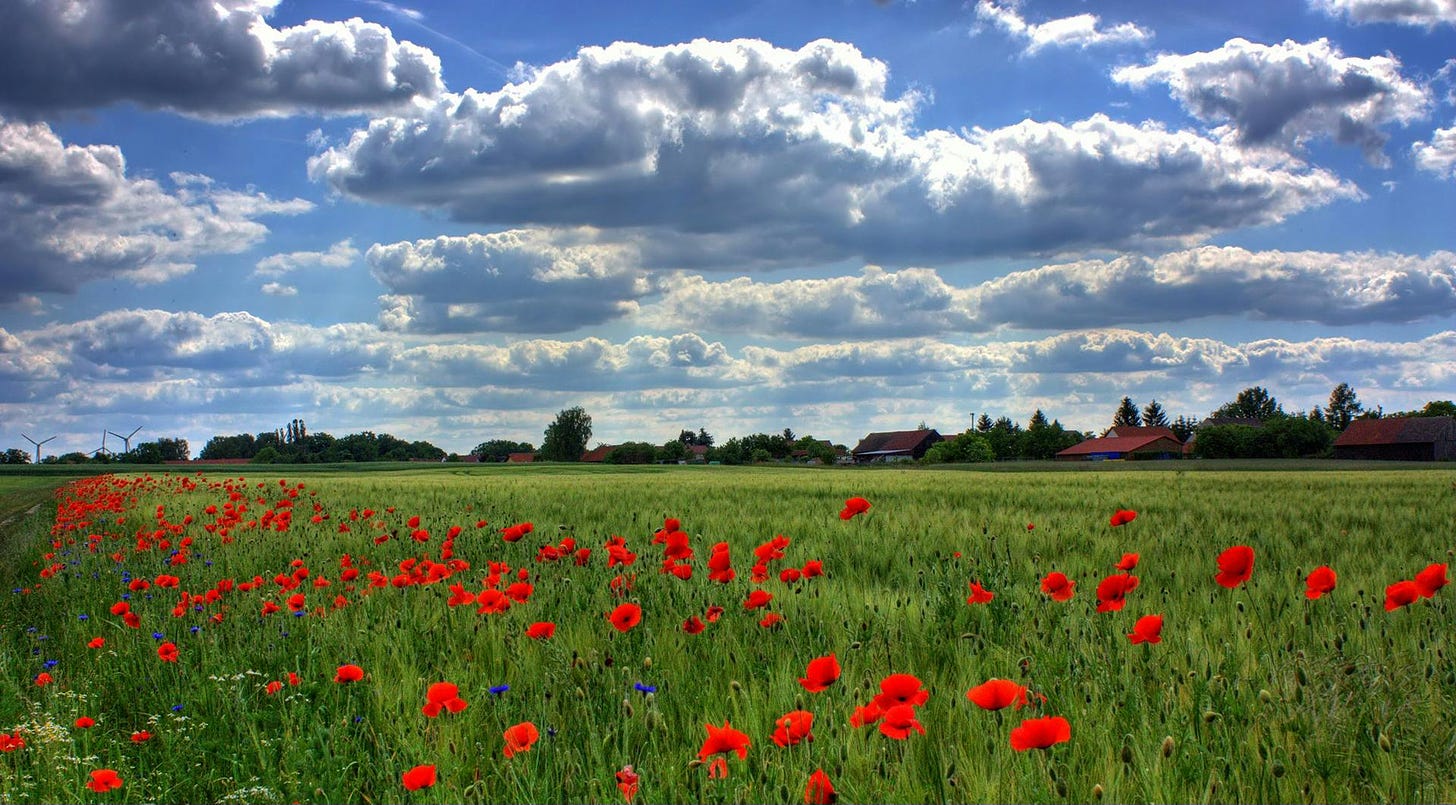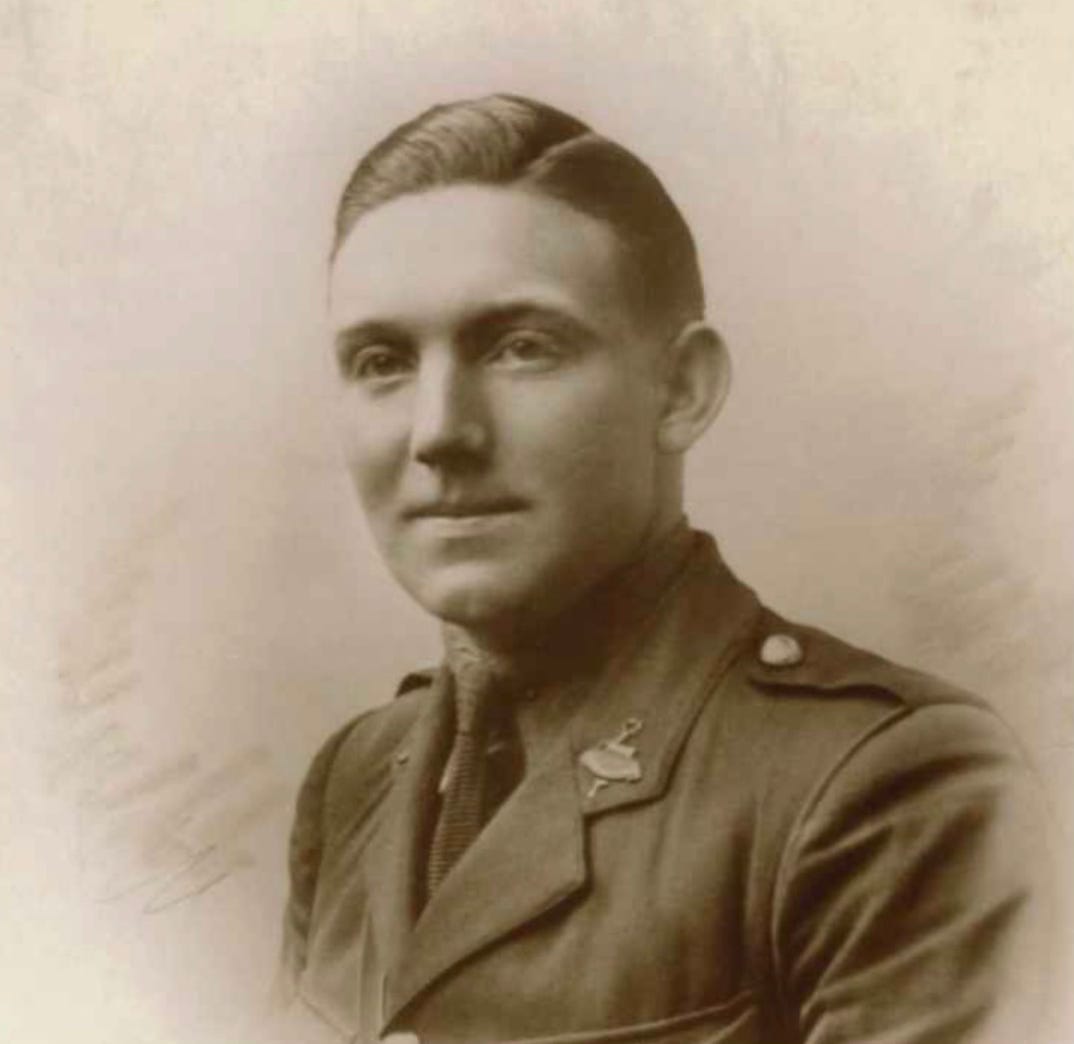They shall grow not old, as we that are left grow old:
Age shall not weary them, nor the years condemn.
At the going down of the sun and in the morning
We will remember them.
For The Fallen, by Laurence Binyon.
……………..
You take the road a couple of miles south of the D930 from Bapaume to Cambrai deep in the unprepossessing Pas de Calais region of France.
From there you take the D34 for a mile or so, until you see a sign that informs the driver that a Commonwealth War Graves Cemetery is near.
Eventually you reach your destination. The Hermies Hill Cemetery lies on the left hand side of the road.
The final resting place of Hitchin's only recipient of the Victory Cross. The highest award, given only to the bravest of the brave.
You park your car, and are presented with an immaculately manicured lawn, guarded by neatly trimmed hedgerows marshalled on either side.
The earth gently rises, and a number of stone white, bright white, headstones stand tall and unbowed.
Surrounded by a brick wall, in rich earth, these proud gravestones honour heroes. British servicemen from World War One who made the ultimate sacrifice.
Young men, cut down in the prime of their lives, are interred in a corner of a foreign field, that is for ever England.
Here in this hallowed ground lies the grave of Frank Young. VC.
………..
The gravestone simply reads: 'Second Lieutenant FE Young VC, Hertfordshire Regiment. 18th September 1918. Age 23.'
Underneath is an inscription: 'There is no gain/Except by loss/There is no life/Except by death.'
The line is from an 1872 poem called 'My son sinks without clouds or fears' by a Scottish author and poet called Rev Dr Walter Chalmers Smith, who also wrote the hymn, 'Immortal, Invisible, God Only Wise'.
In a restorative calm, the only sound is a contemplative silence.
And in the fading light, on a gunmetal grey afternoon, in an unremarkable part of northern France, you close your eyes and try and imagine the scene a century previously.
……….
Frank Young VC
The army was in Frank's DNA.
At the tender age of 14, in 1909, he became a boy bugler in the Territorial Force's Hertfordshire Regiment.
He served in the Hitchin Company, which would morph into D Company - or No4 Company. A group he would be leading on the day he died.
It wasn't surprising he was steeped in the services, given his father, Frank senior, was also an army man, serving in the 1st Battalion of the Bedfordshire Regiment in India's north west province as a colour sergeant.
Which is where Frank junior was born, in the town of Cherat, on October 2, 1895.
Frank senior, was born on March 27, 1874, the son of a Sarah Fensome and an unnamed father. He signed up to the Bedfordshire Regiment as a private in 1889 and was promoted to sergeant in four years later.
When the Great War broke out on August 4, 1914, the teenage Frank was firmly ensconced in the Hertfordshire Regiment as a private, with his father serving as 'Company Sergeant Major 3292' of the 2nd battalion.
Troops from Hitchin and its surrounding areas were mobilised to the Western Front in November 1914, but an undisclosed medical operation prevented Frank junior from crossing the channel until the new year, when he travelled in a reinforcement draft, landing on French shores on January 21, 1915.
Frank Young: A leader of men
He took quickly to military operations, soon becoming a regimental scout.
Within months he moved to sergeant, gaining a reputation as a leader of men, a reliable scout and, intriguingly, good with explosives.
The Battle of Loos
1915, he bravely fought in the Battle of Loos, alongside his father, Frank senior, now the 'Battalion Sergeant Major', who was mentioned in despatches.
The fighting, which took place between September 25 and October 8, was the biggest British attack against German forces in the whole of 1915.
It was the first battle that involved the 'New Army', or 'Kitchener's Army' – volunteers consisting of many thousands of men who signed up in that euphoric wave of patriotism back in the heady days of August 1914.
Among the barbed wire and the machine gun nests, the Battle of Loos also marked the first time poison gas had been used by the British in a military operation.
It was not a success.
Frank's regiment endures poison gas
After the Germans had employed the deadly toxins in the Second Battle of Ypres in April of 1915, chlorine, codenamed Red Star, was the agent used by the British.
For something so lethal, the use of the gas was solely dependent on a favourable wind – and the late September weather in Artois and Champagne proved to be fickle.
Once released, the gas lingered in no man's land between the warring positions, or worse, blew back into British trenches.
Those who suffered most were found to be those found on the ground of the labyrinthine warrens, either in a bid to escape the deadly agent, or because they lay prone on stretchers with previous wounds. The gas was merciless, killing and debilitating many.
…………..
Frank's explosive taste for mechanics
Frank survived the horrific killing agent known as poison gas to earn a month's leave in early 1916.
Still only 19 years of age, Frank had a love of all things mechanical, having earned a reputation for working diligently with explosives.
He was sent to serve as a 'bombing instructor' in late spring of 1916, in Rouen, the town where Joan of Arc was burnt to death in 1431 during the Hundred Years War, before being canonised as a saint.
An unspecified accident saw him spend three months in Cardiff Military Hospital that summer, before being stationed once again in Herts, this time in Halton Camp, near Tring.
Frank rises through the ranks
As the war took its toll, with the number of officers diminishing through battlefield losses, Frank, thanks to his outstanding service record, his leadership abilities, and through expediency, eventually became a commissioned officer in April 1917.
Such promotions were known as 'temporary gentlemen' as the humour of the 'Tommy' soldiers phrased it. On the form for admission to officer training, one of the class-based questions inquired 'Able to ride?'
In the spring of 1918 second lieutenant Young of Hitchin, was posted into the 3rd/5th Battalion of the Bedfordshire Regiment, who were stationed in Sussex.
Frank, who despite witnessing the horrors of war first hand, not to mention suffering injuries while around explosives, was nothing if not unflappable, with a thirst for sampling new wartime experiences.
Frank's soaring desire for fresh adventures is grounded
Around that time, it seems Frank was fascinated by the Royal Flying Corps.
To such an extent he actually undertook a month and a half's ground training in Berkshire, prior to heading to the flatlands of Lincolnshire, and Sleaford in particular, for practical airbourne training.
However, it appears he was put off signing up to become an aerial fighter with the fledgling RAF, when a flying accident rendered him extremely shaken after another brush with his own mortality, and as a result he returned to the Bedfords.
Final visit back to Hitchin to see his mother
As the 'War to end all Wars' progressed, Frank paid his final trip back to Hitchin, to visit his mother at her house in Verulam Road, in September 1918, before being sent back to the front.
We can only imagine what the meeting was like.
…………………
The day Frank died
After crossing the channel one final time, in France, Frank was posted back to the 1st/1st Hertfordshires as a replacement intended to bolster the losses incurred during the Battles of Albert and Bapaume the month before.
He re-joined the Hertfords on September 12, just as they were gearing up for what would be known as the Battle of Havrincourt, as part of larger battles to attack the Germans' Hindenburg Line.
Fittingly, Frank was put in command of No4 Company - his old Hitchin Company - who were in the line south east of Havrincourt village, near a copse called Triangle Wood.
And so it came to pass, on September 17, a mere seven weeks before the armistice was signed between Great Britain and Germany, marking the end of the four year conflict on November 11, 1918, Frank sent his final communication on a standard field postcard.
It was the day before an unexpected German attack attempted to storm their lines.
Frank Young VC
Frank was last seen fighting hand-to-hand with enemy soldiers and, despite being initially listed as missing, a British patrol, including a second lieutenant Males from Stevenage, found his body on September 27.
The actions that saw Frank win the highest award for gallantry were published in the London Gazette, on December 13, 1918.
"For most conspicuous bravery, determination and exceptional devotion to duty on September 18, 1918, south-east of Havrincourt, when during an enemy counter-attack and throughout an extremely intense enemy barrage he visited all posts, warned the garrisons and encouraged the men.
"In the early stages of the attack he rescued two of his men who had been captured and bombed and silenced an enemy machine gun.
"Although surrounded by the enemy, 2nd Lt. Young fought his way back to the main barricade and drove out a party of the enemy who were assembling there."
................
A north Herts contemporary of Frank's, Douglas William Chisholm, a bookbinder, who moved from Edinburgh to the Elephant & Castle in London, and then to Letchworth to work at the Temple Press of the publishing firm J.M. Dent, would never talk about his and Young's war service.
Except briefly, in his later years, to tell his grandson, Michael George, about his army colleague's VC.
'He earned it boy. He earned it," is all that he would say about his pal Frank.
………….
We will remember them
Frank Young is Hitchin's only VC winner, one of just two soldiers from the Hertfordshire regiment to receive the award, and the only one to be killed in doing so.
Frank Young VC is buried at the Hermies Hill British Cemetery in Hermies, a couple of miles south of the D930 from Bapaume to Cambrai, deep in the unprepossessing Pas de Calais region of France.
The final resting place of Hitchin's only recipient of the Victory Cross.
The highest award, given only to the bravest of the brave.
…………..
They shall grow not old, as we that are left grow old:
Age shall not weary them, nor the years condemn.
At the going down of the sun and in the morning
We will remember them.
For The Fallen, by Laurence Binyon.
................
................
................
Sources/Research:
The Imperial War Museum
The comprehensive guide to the Victoria and George Cross
The Story of the Bedfordshire and Hertfordshire Regiment, Volume II
The Bedfordshire Regiment in the Great War
The Battle of Loos
@DanHillHistory
A Short History of Chemical Warfare from World War I
War Poetry
Walter Chalmers Smith, The Canterbury Dictionary of Hymnology.
Royal British Legion, Hitchin branch
Commonwealth War Graves Commission
Michael George




